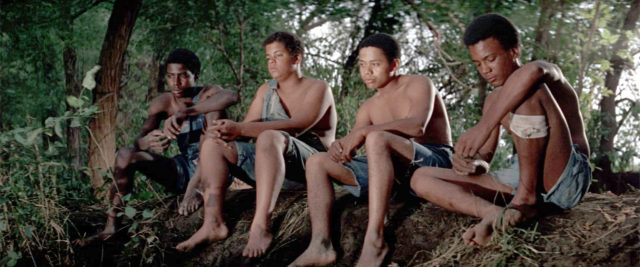
Any town is sort of like a fruit tree: Some of the people are good, some of them are bad. Just like the fruit on a tree. No matter if you go or stay, think of it like that until the day you die. Let it be your learning tree.
A man is shot in the back. He’s Black, and the man doing the shooting is white. That’s Sheriff Kirky (Dana Elcar), and when everything is said and done, Kirky’ll shoot another Black man in the back. Both victims were unarmed; both posed no threat to Kirky. But gun them down, Kirky did, and in broad daylight with witnesses. How those witnesses react—or don’t—says more than the best writers could muster with a thousand words.
Written, produced, directed and scored by Gordon Parks, 1969’s The Learning Tree was the first time a Hollywood studio financed a commercial film by a Black filmmaker. They found a gem in Parks, the multi-hyphenate artist with roots in still photography. In 1963, Life published a two-part feature from Parks, “How it Feels to be Black,” in conjunction with Park’s semi-autobiographical novel, The Learning Tree. Five years later, Warner Bros. inked the deal for Parks’ first feature, and Parks gathered an impressive crew of white and Black talent and headed back to his hometown of Fort Scott, Kansas, to film his coming-of-age story.
Set in the 1920s, The Learning Tree opens with a twister tearing across the Kansas plains. It doesn’t transport Newton (Kyle Johnson) to Oz, just to the shed where he shares the night with Big Mabel (Carole Lamond), a local vamp who doesn’t exactly usher Newt into manhood but does make him the envy of his peers nonetheless. Newton, or Newt to just about everyone, is young. Soon he will fall for a girl closer in age (Mira Waters), fight with one of his friends, Marcus (Alex Clarke), suffer racism direct and indirect, witness the death of three men, and have to decide the fate of an innocent man—even if his confession causes the creation of a lynch mob. That Parks’ weaves race relations and a potential riot into Newt’s moral quandary speaks as much to the volatility of the Civil Rights era in which the movie was released as it does to the era of oppression in which the story is set.
Though The Learning Tree is a landmark in Hollywood cinema, it is not without flaws. The story is largely episodic and feels meandering at times. But the subtle ways Parks manages to introduce and payoff secondary characters floating through Newt’s life—Big Mable is around to save Newt more than once—enriches the tale a posteriori. Johnson and Clarke’s performances are somewhat stiff, but the supporting cast is so rich you wouldn’t mind spending more time with them. From Newt’s mother (Estelle Evans), who speaks softly and in parables until she snaps at Kirky in one of the movie’s funniest moments, to Marcus’ father, Booker Savage (Richard Ward), an illiterate and abusive drunk whose presence feels like stereotype until he is allowed a handful of dialogue. He makes a meal out of nothing more than comments uttered under one’s breath and a pointed remark at Sheriff Kirky. In another movie, Booker might be complacent or two-faced. Here, Parks allows him to be a real individual, flaws and all.
Those layers are the real strength of The Learning Tree. In one scene, the school principal laments the racism of the teachers but expresses helplessness to change anything. In another, a young white kid runs to congratulate Newt for winning a boxing match but calls him “sambo” when he does. Booker may be an abusive drunk, but he still sets the table with the good plates when his son returns from prison. Good fruit and bad, all are Newt’s learning tree.
But can Newt reconcile them long enough to find a way out? Parks found his: “I’ve had to make compromises during my lifetime. I had to choose between the knife, the gun, or my talents.” With a bit of luck, Park chose his talents. It wasn’t easy, but he found a way, and in 1989, when the Library of Congress decided it was high time to introduce cinematic works of cultural, historical or aesthetic significance into the National Film Registry, The Learning Tree was among the first class of inductees.
But The Learning Tree wasn’t a commercial success—it made only $1.5 million at the box office on an estimated $2 million budget—and in certain corners of cinematic discourse it has fallen out of favor, shadowed by Parks’ second, much more popular, film: 1971’s Shaft. But even that film is discussed more in connection to the Blaxploitation movement of the 1970s than in relation to Parks’ career. That’s what makes Criterion’s release of The Learning Tree so welcome: It resurrects Parks’ cachet at a time when cineastes are beginning to appreciate more Black filmmakers. In addition to a new 2K digital restoration of The Learning Tree, Criterion’s set includes two documentaries about Parks making The Learning Tree, a short documentary constructed from Parks’ photography, another documentary directed by Parks, interviews with artists, activists, and scholars about Parks’ legacy, and a booklet containing part of Parks’ Life story, “How it Feels to be Black” and an excerpt from his memoir, A Hungry Heart.














